Deck 6: An Introduction to Macroeconomics
Question
Question
Question
Question
Question
Question
Question
Question
Question
Question
Question
Question
Question
Question
Question
Question
Question
Question
Question
Question
Question
Question
Question
Question
Question
Question
Question
Question
Question
Question
Question
Question
Question
Question
Question
Question
Question
Question
Question
Question
Question
Question
Question
Question
Question
Question
Question
Question
Question
Question
Question
Question
Question
Question
Question
Question
Question
Question
Question
Question
Question
Question
Question
Question
Question
Question
Question
Question
Question
Question
Question
Question
Question
Question
Question
Question
Question
Question
Question
Question

Unlock Deck
Sign up to unlock the cards in this deck!
Unlock Deck
Unlock Deck
1/243
Play
Full screen (f)
Deck 6: An Introduction to Macroeconomics
1
Harry's Pepperoni Pizza Parlor produced 10,000 large pepperoni pizzas last year that sold for $10 each. This year Harry's again produced 10,000 large pepperoni pizzas (identical to last year's pizzas)
But sold them for $12 each. Based on this information, we can conclude that Harry's production of
Large pepperoni pizzas
A) increased both nominal and real GDP from last year.
B) increased nominal GDP from last year, but real GDP was unaffected.
C) increased real GDP from last year, but nominal GDP was unaffected.
D) did not change either nominal or real GDP from last year.
But sold them for $12 each. Based on this information, we can conclude that Harry's production of
Large pepperoni pizzas
A) increased both nominal and real GDP from last year.
B) increased nominal GDP from last year, but real GDP was unaffected.
C) increased real GDP from last year, but nominal GDP was unaffected.
D) did not change either nominal or real GDP from last year.
increased nominal GDP from last year, but real GDP was unaffected.
2
Unemployment describes the condition where
A) equipment and machinery are going unused.
B) a person cannot get a job but is willing to work and is actively seeking work.
C) a person does not have a job, regardless of whether or not he or she wants one.
D) any resource sits idle.
A) equipment and machinery are going unused.
B) a person cannot get a job but is willing to work and is actively seeking work.
C) a person does not have a job, regardless of whether or not he or she wants one.
D) any resource sits idle.
a person cannot get a job but is willing to work and is actively seeking work.
3
Why are high rates of unemployment of concern to economists?
A) Higher rates of unemployment generally lead to higher inflation rates.
B) Environmental destruction is more prevalent when unemployment rates are high.
C) There is lost output that could have been produced if the unemployed had been working.
D) All of these options are reasons why economists are concerned about high unemployment rates.
A) Higher rates of unemployment generally lead to higher inflation rates.
B) Environmental destruction is more prevalent when unemployment rates are high.
C) There is lost output that could have been produced if the unemployed had been working.
D) All of these options are reasons why economists are concerned about high unemployment rates.
There is lost output that could have been produced if the unemployed had been working.
4
Which of the following statements is accurate about most economies?
A) Economies experience a positive growth trend over the short run but experience significant variability in the long run.
B) Economies experience a positive growth trend over the long run but experience significant variability in the short run.
C) Economies experience positive and stable growth over both the long run and short run.
D) Economies experience little long-run growth in output but can experience significant growth in the short run.
A) Economies experience a positive growth trend over the short run but experience significant variability in the long run.
B) Economies experience a positive growth trend over the long run but experience significant variability in the short run.
C) Economies experience positive and stable growth over both the long run and short run.
D) Economies experience little long-run growth in output but can experience significant growth in the short run.

Unlock Deck
Unlock for access to all 243 flashcards in this deck.
Unlock Deck
k this deck
5
Macroeconomics is mostly focused on
A) the individual markets within an economy.
B) only the largest industries in the economy.
C) the economy as a whole.
D) why specific businesses fail.
A) the individual markets within an economy.
B) only the largest industries in the economy.
C) the economy as a whole.
D) why specific businesses fail.

Unlock Deck
Unlock for access to all 243 flashcards in this deck.
Unlock Deck
k this deck
6
Why are economists concerned about inflation?
A) Inflation generally causes unemployment rates to rise.
B) Real GDP is necessarily falling when there is inflation.
C) Inflation lowers the standard of living for people whose income does not increase as fast as the price level.
D) Inflation increases the value of people's savings and encourages overspending on goods and services.
A) Inflation generally causes unemployment rates to rise.
B) Real GDP is necessarily falling when there is inflation.
C) Inflation lowers the standard of living for people whose income does not increase as fast as the price level.
D) Inflation increases the value of people's savings and encourages overspending on goods and services.

Unlock Deck
Unlock for access to all 243 flashcards in this deck.
Unlock Deck
k this deck
7
Inflation is defined as
A) a general increase in the price level.
B) the rate of growth in nominal GDP.
C) a situation where all prices in the economy rise simultaneously.
D) the growth phase of the business cycle.
A) a general increase in the price level.
B) the rate of growth in nominal GDP.
C) a situation where all prices in the economy rise simultaneously.
D) the growth phase of the business cycle.

Unlock Deck
Unlock for access to all 243 flashcards in this deck.
Unlock Deck
k this deck
8
Before the period of modern economic growth,
A) only civilizations such as the Roman Empire experienced economic growth.
B) rates of population growth virtually matched rates of output growth.
C) most economies realized high rates of growth in output per person.
D) output and population growth were stagnant.
A) only civilizations such as the Roman Empire experienced economic growth.
B) rates of population growth virtually matched rates of output growth.
C) most economies realized high rates of growth in output per person.
D) output and population growth were stagnant.

Unlock Deck
Unlock for access to all 243 flashcards in this deck.
Unlock Deck
k this deck
9
Which of the following is most closely related to recessions?
A) positive long-run economic growth
B) rapid growth in the price level
C) falling rates of unemployment
D) negative real growth in output
A) positive long-run economic growth
B) rapid growth in the price level
C) falling rates of unemployment
D) negative real growth in output

Unlock Deck
Unlock for access to all 243 flashcards in this deck.
Unlock Deck
k this deck
10
Modern economic growth refers to countries that have experienced an increase in
A) real GDP over time.
B) nominal GDP over time.
C) real output spread evenly across all sectors of the economy.
D) output per person.
A) real GDP over time.
B) nominal GDP over time.
C) real output spread evenly across all sectors of the economy.
D) output per person.

Unlock Deck
Unlock for access to all 243 flashcards in this deck.
Unlock Deck
k this deck
11
Harry's Pepperoni Pizza Parlor produced 10,000 large pepperoni pizzas last year that sold for $10 each. This year Harry's again produced 10,000 large pepperoni pizzas (identical to last year's pizzas)
But sold them for $12 each. Based on this information, we can conclude that Harry's production of
Large pepperoni pizzas this year
A) increased nominal GDP by $20,000 but left real GDP unchanged.
B) increased nominal GDP by $120,000 and increased real GDP by $100,000.
C) left nominal GDP unchanged but increased real GDP by $20,000.
D) increased nominal GDP by $120,000 but left real GDP unchanged.
But sold them for $12 each. Based on this information, we can conclude that Harry's production of
Large pepperoni pizzas this year
A) increased nominal GDP by $20,000 but left real GDP unchanged.
B) increased nominal GDP by $120,000 and increased real GDP by $100,000.
C) left nominal GDP unchanged but increased real GDP by $20,000.
D) increased nominal GDP by $120,000 but left real GDP unchanged.

Unlock Deck
Unlock for access to all 243 flashcards in this deck.
Unlock Deck
k this deck
12
Harry's Pizza Parlor produced 10,000 large pizzas last year that sold for $10 each. This year Harry's produced 11,000 large pizzas (identical to last year's pizzas) but sold them for $12 each. Based on
This information, we can conclude that Harry's production of large pizzas
A) increased nominal GDP from last year, but real GDP was unaffected.
B) increased both nominal and real GDP from last year.
C) increased real GDP from last year, but nominal GDP was unaffected.
D) did not change either nominal or real GDP from last year.
This information, we can conclude that Harry's production of large pizzas
A) increased nominal GDP from last year, but real GDP was unaffected.
B) increased both nominal and real GDP from last year.
C) increased real GDP from last year, but nominal GDP was unaffected.
D) did not change either nominal or real GDP from last year.

Unlock Deck
Unlock for access to all 243 flashcards in this deck.
Unlock Deck
k this deck
13
The term "recession" describes a situation where
A) inflation rates exceed normal levels.
B) output and living standards decline.
C) an economy's ability to produce is destroyed.
D) government takes a less active role in economic matters.
A) inflation rates exceed normal levels.
B) output and living standards decline.
C) an economy's ability to produce is destroyed.
D) government takes a less active role in economic matters.

Unlock Deck
Unlock for access to all 243 flashcards in this deck.
Unlock Deck
k this deck
14
The two topics of primary concern in macroeconomics are
A) short-run fluctuations in output and employment and long-run economic growth.
B) unemployment and wage rates in labor markets.
C) monopoly power of corporations and small business profitability.
D) oil prices and housing markets.
A) short-run fluctuations in output and employment and long-run economic growth.
B) unemployment and wage rates in labor markets.
C) monopoly power of corporations and small business profitability.
D) oil prices and housing markets.

Unlock Deck
Unlock for access to all 243 flashcards in this deck.
Unlock Deck
k this deck
15
Real GDP measures the
A) total dollar value of all goods and services produced within the borders of a country using current prices.
B) value of final goods and services produced within the borders of a country, adjusted for price changes.
C) total dollar value of all goods and services consumed within the borders of a country, corrected for price changes.
D) value of all goods and services produced in the world, using current prices.
A) total dollar value of all goods and services produced within the borders of a country using current prices.
B) value of final goods and services produced within the borders of a country, adjusted for price changes.
C) total dollar value of all goods and services consumed within the borders of a country, corrected for price changes.
D) value of all goods and services produced in the world, using current prices.

Unlock Deck
Unlock for access to all 243 flashcards in this deck.
Unlock Deck
k this deck
16
The three statistics that are the main focus for those measuring macroeconomic health are
A) real GDP, inflation, and unemployment.
B) real GDP, nominal GDP, and inflation.
C) nominal GDP, unemployment, and inflation.
D) real GDP, nominal GDP, and unemployment.
A) real GDP, inflation, and unemployment.
B) real GDP, nominal GDP, and inflation.
C) nominal GDP, unemployment, and inflation.
D) real GDP, nominal GDP, and unemployment.

Unlock Deck
Unlock for access to all 243 flashcards in this deck.
Unlock Deck
k this deck
17
Higher rates of unemployment are linked with
A) greater political stability because the employed tend to be more politically active.
B) higher crime rates, as the unemployed seek to replace lost income.
C) lower rates of heart disease, as the unemployed have eliminated job stress.
D) improvements in overall health, as the unemployed have more leisure time to be physically active.
A) greater political stability because the employed tend to be more politically active.
B) higher crime rates, as the unemployed seek to replace lost income.
C) lower rates of heart disease, as the unemployed have eliminated job stress.
D) improvements in overall health, as the unemployed have more leisure time to be physically active.

Unlock Deck
Unlock for access to all 243 flashcards in this deck.
Unlock Deck
k this deck
18
Real GDP is preferred to nominal GDP as a measure of economic performance because
A) nominal GDP uses current prices and thus may over or understate true changes in output.
B) nominal GDP only includes goods and excludes services.
C) nominal GDP is not adjusted for population changes.
D) real GDP accounts for changes in the quality of goods and services produced.
A) nominal GDP uses current prices and thus may over or understate true changes in output.
B) nominal GDP only includes goods and excludes services.
C) nominal GDP is not adjusted for population changes.
D) real GDP accounts for changes in the quality of goods and services produced.

Unlock Deck
Unlock for access to all 243 flashcards in this deck.
Unlock Deck
k this deck
19
The business cycle depicts
A) fluctuations in the general price level.
B) the phases a business goes through from when it first opens to when it finally closes.
C) the evolution of technology over time.
D) short-run fluctuations in output and employment.
A) fluctuations in the general price level.
B) the phases a business goes through from when it first opens to when it finally closes.
C) the evolution of technology over time.
D) short-run fluctuations in output and employment.

Unlock Deck
Unlock for access to all 243 flashcards in this deck.
Unlock Deck
k this deck
20
If the prices of all goods and services rose, but the quantity produced remained unchanged, what would happen to nominal and real GDP?
A) Nominal and real GDP would both rise.
B) Nominal and real GDP would both be unchanged.
C) Real GDP would rise, but nominal GDP would be unchanged.
D) Nominal GDP would rise, but real GDP would be unchanged.
A) Nominal and real GDP would both rise.
B) Nominal and real GDP would both be unchanged.
C) Real GDP would rise, but nominal GDP would be unchanged.
D) Nominal GDP would rise, but real GDP would be unchanged.

Unlock Deck
Unlock for access to all 243 flashcards in this deck.
Unlock Deck
k this deck
21
Banks and other financial institutions
A) are the primary investors in equipment, factories, and other capital goods.
B) lack relevance in the modern economy because they focus primarily on financial assets and generally do not engage in real investment activity.
C) promote economic growth by helping to direct household savings to businesses that want to invest.
D) often hinder economic activity by creating barriers between household savers and firms wanting to invest in capital goods.
A) are the primary investors in equipment, factories, and other capital goods.
B) lack relevance in the modern economy because they focus primarily on financial assets and generally do not engage in real investment activity.
C) promote economic growth by helping to direct household savings to businesses that want to invest.
D) often hinder economic activity by creating barriers between household savers and firms wanting to invest in capital goods.

Unlock Deck
Unlock for access to all 243 flashcards in this deck.
Unlock Deck
k this deck
22
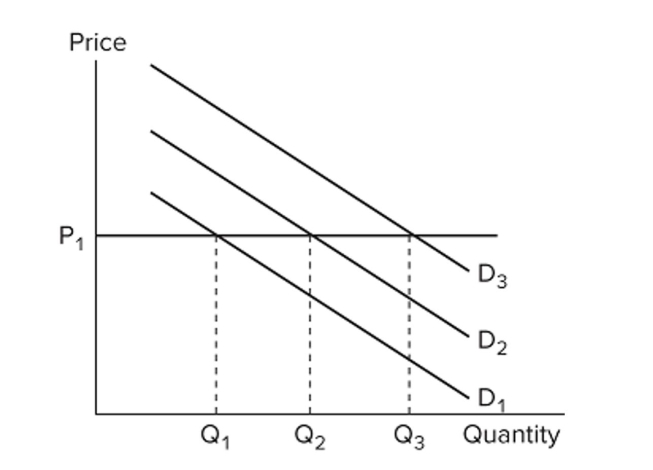 Refer to the figure. Assuming this market is representative of the economy as a whole, this economy
Refer to the figure. Assuming this market is representative of the economy as a whole, this economyA) is highly susceptible to inflation.
B) faces fluctuating output levels whenever there is a demand shock.
C) is capable of always producing at its optimal capacity.
D) is largely immune to business cycles.

Unlock Deck
Unlock for access to all 243 flashcards in this deck.
Unlock Deck
k this deck
23
Suppose that Techno Co. produces laptop computers. At a price of $1,000 per laptop, Techno determines that its optimal output is 3,000 laptops per week. If prices are sticky and fears of a
Recession reduce demand for laptop computers, we would expect Techno to
A) reduce output in the long run.
B) reduce output in the short run.
C) raise prices in the short run to compensate for lost revenue.
D) lower prices in the short run to offset the reduced demand.
Recession reduce demand for laptop computers, we would expect Techno to
A) reduce output in the long run.
B) reduce output in the short run.
C) raise prices in the short run to compensate for lost revenue.
D) lower prices in the short run to offset the reduced demand.

Unlock Deck
Unlock for access to all 243 flashcards in this deck.
Unlock Deck
k this deck
24
If an economy wants to increase its current level of investment, it must
A) sacrifice future consumption.
B) print more money.
C) offer more stocks and bonds to financial investors.
D) sacrifice current consumption.
A) sacrifice future consumption.
B) print more money.
C) offer more stocks and bonds to financial investors.
D) sacrifice current consumption.

Unlock Deck
Unlock for access to all 243 flashcards in this deck.
Unlock Deck
k this deck
25
For an economy to increase investment, it must
A) increase saving.
B) increase present consumption.
C) buy more stocks and bonds.
D) increase nominal GDP.
A) increase saving.
B) increase present consumption.
C) buy more stocks and bonds.
D) increase nominal GDP.

Unlock Deck
Unlock for access to all 243 flashcards in this deck.
Unlock Deck
k this deck
26
Increased present saving
A) comes at the expense of reduced current investment.
B) comes at the expense of reduced current consumption.
C) can only occur if the government increases the amount of money in circulation.
D) is only possible if the economy is experiencing positive growth in real GDP.
A) comes at the expense of reduced current investment.
B) comes at the expense of reduced current consumption.
C) can only occur if the government increases the amount of money in circulation.
D) is only possible if the economy is experiencing positive growth in real GDP.

Unlock Deck
Unlock for access to all 243 flashcards in this deck.
Unlock Deck
k this deck
27
Shocks to the economy occur
A) when expectations are unmet.
B) whenever the price level changes.
C) whenever government implements fiscal or monetary policy.
D) because most economic behavior is unpredictable.
A) when expectations are unmet.
B) whenever the price level changes.
C) whenever government implements fiscal or monetary policy.
D) because most economic behavior is unpredictable.

Unlock Deck
Unlock for access to all 243 flashcards in this deck.
Unlock Deck
k this deck
28
Shocks to the economy occur when
A) stock prices rise by more than 10 percent per year.
B) government takes a more active role in the economy.
C) prices are flexible.
D) actual economic events do not match what people expected.
A) stock prices rise by more than 10 percent per year.
B) government takes a more active role in the economy.
C) prices are flexible.
D) actual economic events do not match what people expected.

Unlock Deck
Unlock for access to all 243 flashcards in this deck.
Unlock Deck
k this deck
29
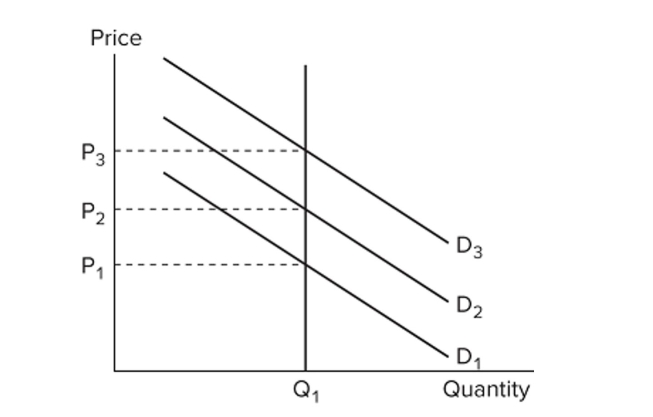 Refer to the figure. Assuming this market is representative of the economy as a whole, a positive demand shock will
Refer to the figure. Assuming this market is representative of the economy as a whole, a positive demand shock willA) increase both the price level and the quantity of output produced.
B) increase output but leave prices unchanged.
C) lower the price level but leave output unchanged.
D) raise the price level but leave output unchanged.

Unlock Deck
Unlock for access to all 243 flashcards in this deck.
Unlock Deck
k this deck
30
Savings are generated whenever
A) prices are rising.
B) current spending exceeds current income.
C) current income exceeds current spending.
D) real GDP exceeds nominal GDP.
A) prices are rising.
B) current spending exceeds current income.
C) current income exceeds current spending.
D) real GDP exceeds nominal GDP.

Unlock Deck
Unlock for access to all 243 flashcards in this deck.
Unlock Deck
k this deck
31
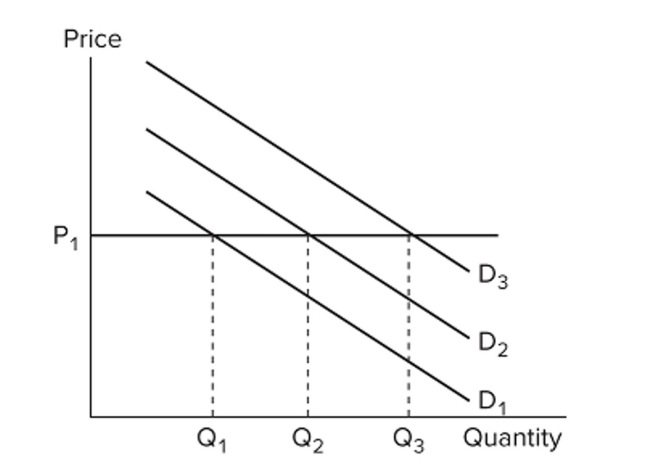 The figure depicts a situation where
The figure depicts a situation whereA) prices are sticky, but output is flexible.
B) prices are flexible, but output is constant.
C) prices and output are both flexible.
D) prices are sticky and output is constant.

Unlock Deck
Unlock for access to all 243 flashcards in this deck.
Unlock Deck
k this deck
32
Demand shocks
A) refer to unexpected changes in the desires of households and businesses to buy goods and services.
B) refer to unexpected changes in the ability of firms to produce and sell goods and services.
C) always have a negative effect on the economy.
D) cause fewer short-run fluctuations than supply shocks.
A) refer to unexpected changes in the desires of households and businesses to buy goods and services.
B) refer to unexpected changes in the ability of firms to produce and sell goods and services.
C) always have a negative effect on the economy.
D) cause fewer short-run fluctuations than supply shocks.

Unlock Deck
Unlock for access to all 243 flashcards in this deck.
Unlock Deck
k this deck
33
When economists refer to "investment," they are describing a situation where
A) people are buying shares of corporate stock.
B) resources are devoted to increasing future output.
C) money is saved in a bank account.
D) financial assets are purchased in the hope of a monetary gain.
A) people are buying shares of corporate stock.
B) resources are devoted to increasing future output.
C) money is saved in a bank account.
D) financial assets are purchased in the hope of a monetary gain.

Unlock Deck
Unlock for access to all 243 flashcards in this deck.
Unlock Deck
k this deck
34
Which of the following is used to compare the average standard of living across countries?
A) real GDP
B) nominal GDP
C) purchasing power parity
D) GDP per person
A) real GDP
B) nominal GDP
C) purchasing power parity
D) GDP per person

Unlock Deck
Unlock for access to all 243 flashcards in this deck.
Unlock Deck
k this deck
35
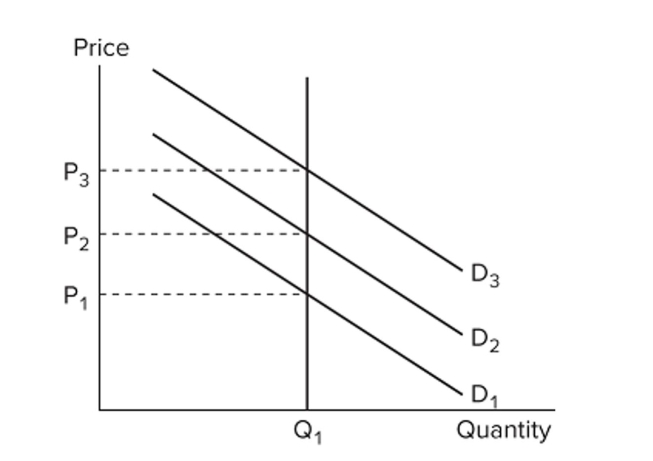 The figure depicts a situation where
The figure depicts a situation whereA) prices are sticky, but output is flexible.
B) prices are flexible, but output is constant.
C) prices and output are both flexible.
D) prices are sticky and output is constant.

Unlock Deck
Unlock for access to all 243 flashcards in this deck.
Unlock Deck
k this deck
36
Which of the following is an example of a demand shock?
A) Hurricane Harry knocks out oil drilling platforms in the Gulf of Mexico.
B) Consumers become worried about job loss and buy fewer goods and services than expected.
C) Floods in the Midwest destroy crops.
D) The federal government unexpectedly requires automobile producers to raise fuel efficiency standards.
A) Hurricane Harry knocks out oil drilling platforms in the Gulf of Mexico.
B) Consumers become worried about job loss and buy fewer goods and services than expected.
C) Floods in the Midwest destroy crops.
D) The federal government unexpectedly requires automobile producers to raise fuel efficiency standards.

Unlock Deck
Unlock for access to all 243 flashcards in this deck.
Unlock Deck
k this deck
37
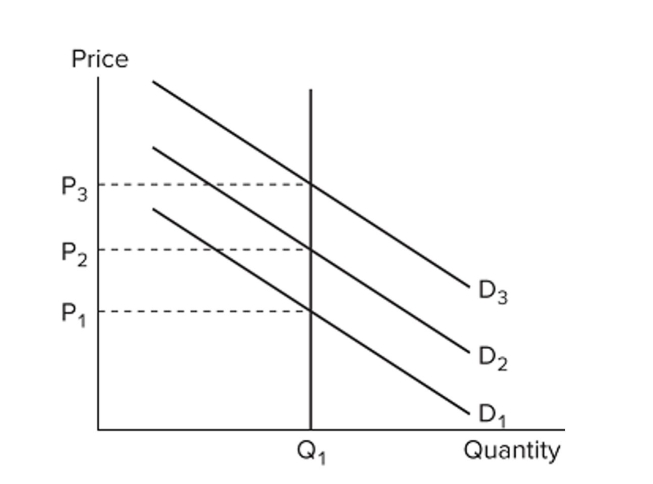 Refer to the figure. Assuming this market is representative of the economy as a whole, a negative demand shock will
Refer to the figure. Assuming this market is representative of the economy as a whole, a negative demand shock willA) cause inflation.
B) increase unemployment.
C) lower prices but leave output unaffected.
D) reduce both prices and output.

Unlock Deck
Unlock for access to all 243 flashcards in this deck.
Unlock Deck
k this deck
38
When demand shocks lead to recessions, it is mainly due to
A) price inflexibility.
B) the inability of government policy to affect demand.
C) unexpected changes in the supply of goods and services.
D) government regulations that prevent firms from adjusting output in response to the shocks.
A) price inflexibility.
B) the inability of government policy to affect demand.
C) unexpected changes in the supply of goods and services.
D) government regulations that prevent firms from adjusting output in response to the shocks.

Unlock Deck
Unlock for access to all 243 flashcards in this deck.
Unlock Deck
k this deck
39
Which of the following would an economist consider to be investment?
A) Boeing builds a new factory
B) Oprah buys a $10 million home from a fellow celebrity
C) a stockbroker buys 10,000 shares of Starbucks stock
D) All of these choices are correct.
A) Boeing builds a new factory
B) Oprah buys a $10 million home from a fellow celebrity
C) a stockbroker buys 10,000 shares of Starbucks stock
D) All of these choices are correct.

Unlock Deck
Unlock for access to all 243 flashcards in this deck.
Unlock Deck
k this deck
40
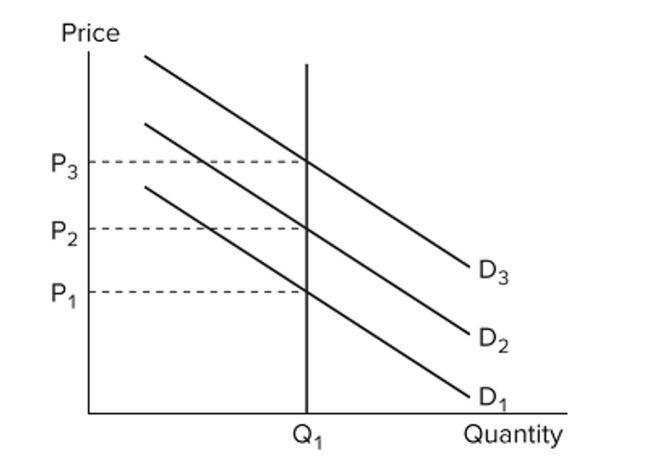 Refer to the figure. Assuming this market is representative of the economy as a whole, this economy
Refer to the figure. Assuming this market is representative of the economy as a whole, this economyA) is highly susceptible to recessions and high unemployment.
B) faces regularly fluctuating output levels in response to demand shocks.
C) is capable of always producing at its optimal capacity.
D) can only lessen the impacts of business cycles through active government policy.

Unlock Deck
Unlock for access to all 243 flashcards in this deck.
Unlock Deck
k this deck
41
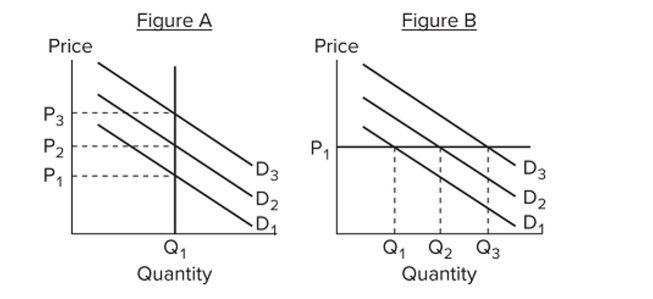 Refer to the figures. Which figure(s) represent(s) a situation where prices are sticky?
Refer to the figures. Which figure(s) represent(s) a situation where prices are sticky?A) A only
B) B only
C) both A and B
D) neither A nor B

Unlock Deck
Unlock for access to all 243 flashcards in this deck.
Unlock Deck
k this deck
42
Prices for airline tickets change hourly. This would suggest that airline ticket prices are
A) stuck.
B) determined in a monopolistic market.
C) relatively sticky.
D) extremely flexible.
A) stuck.
B) determined in a monopolistic market.
C) relatively sticky.
D) extremely flexible.

Unlock Deck
Unlock for access to all 243 flashcards in this deck.
Unlock Deck
k this deck
43
Which of the following statements best describes how firms respond to demand shocks under conditions of inflexible prices?
A) Firms respond to shorter-term demand shocks by adjusting production levels; more persistent changes in demand result in changes in inventories.
B) Firms respond to shorter-term demand shocks by adjusting inventories; more persistent changes in demand result in changes in production levels.
C) Firms are reluctant to adjust inventory levels because the costs are higher than changing the quantity of output produced.
D) Firms are quick to let go of workers when negative demand shocks occur.
A) Firms respond to shorter-term demand shocks by adjusting production levels; more persistent changes in demand result in changes in inventories.
B) Firms respond to shorter-term demand shocks by adjusting inventories; more persistent changes in demand result in changes in production levels.
C) Firms are reluctant to adjust inventory levels because the costs are higher than changing the quantity of output produced.
D) Firms are quick to let go of workers when negative demand shocks occur.

Unlock Deck
Unlock for access to all 243 flashcards in this deck.
Unlock Deck
k this deck
44
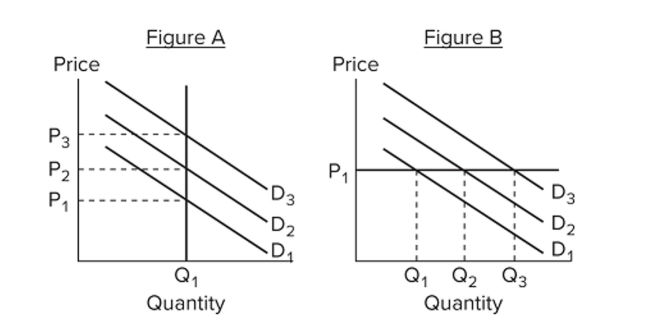 Refer to the figures. As the economy moves from the very short run to the longer run, we would expect
Refer to the figures. As the economy moves from the very short run to the longer run, we would expectA) the representation of the economy to move from Figure A to Figure B.
B) the representation of the economy to move from Figure B to Figure A.
C) demand shocks to be eliminated.
D) the economy to gravitate to P1.

Unlock Deck
Unlock for access to all 243 flashcards in this deck.
Unlock Deck
k this deck
45
In situations of sticky prices and negative demand shocks, we would expect firms to
A) deplete inventories before increasing production.
B) reduce production before building up inventories.
C) build up inventories before reducing production.
D) lower prices before reducing production or building up inventories.
A) deplete inventories before increasing production.
B) reduce production before building up inventories.
C) build up inventories before reducing production.
D) lower prices before reducing production or building up inventories.

Unlock Deck
Unlock for access to all 243 flashcards in this deck.
Unlock Deck
k this deck
46
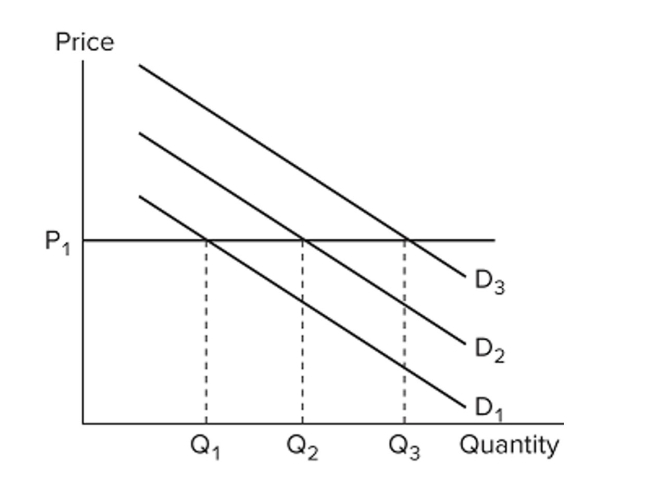 Refer to the figure. Assuming this market is representative of the economy as a whole, a positive demand shock will
Refer to the figure. Assuming this market is representative of the economy as a whole, a positive demand shock willA) increase both the price level and the quantity of output produced.
B) increase output but leave prices unchanged.
C) lower the price level but leave output unchanged.
D) raise the price level but leave output unchanged.

Unlock Deck
Unlock for access to all 243 flashcards in this deck.
Unlock Deck
k this deck
47
For which of the following goods are services prices least sticky?
A) newspapers
B) haircuts
C) microwave ovens
D) airline tickets
A) newspapers
B) haircuts
C) microwave ovens
D) airline tickets

Unlock Deck
Unlock for access to all 243 flashcards in this deck.
Unlock Deck
k this deck
48
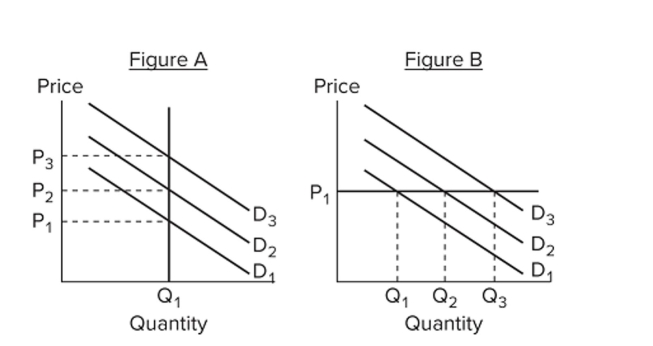 Refer to the figures. Which figure(s) represent(s) a situation where firms are likely to hold inventories to accommodate unexpected changes in demand?
Refer to the figures. Which figure(s) represent(s) a situation where firms are likely to hold inventories to accommodate unexpected changes in demand?A) A only
B) B only
C) both A and B
D) neither A nor B

Unlock Deck
Unlock for access to all 243 flashcards in this deck.
Unlock Deck
k this deck
49
Which of the following statements best describes price flexibility in the economy?
A) Prices tend to be sticky in the short run and stuck in the long run.
B) Prices tend to be just as sticky in the short run as in the long run.
C) Prices tend to be sticky in the short run but become more flexible over time.
D) Prices tend to be flexible in the short run but become more sticky over time.
A) Prices tend to be sticky in the short run and stuck in the long run.
B) Prices tend to be just as sticky in the short run as in the long run.
C) Prices tend to be sticky in the short run but become more flexible over time.
D) Prices tend to be flexible in the short run but become more sticky over time.

Unlock Deck
Unlock for access to all 243 flashcards in this deck.
Unlock Deck
k this deck
50
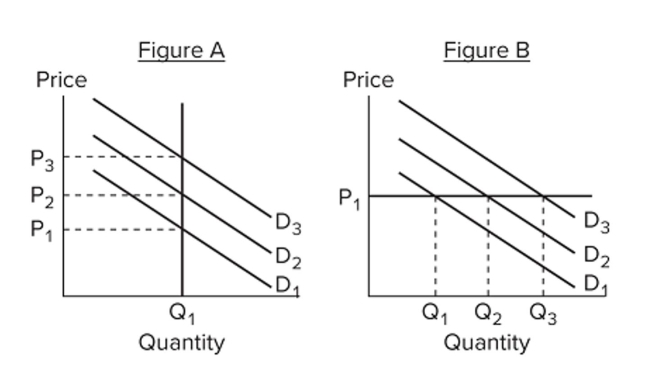 Refer to the figures. In terms of representing the economy,
Refer to the figures. In terms of representing the economy,A) neither Figure A nor Figure B consistently represents either the very short run or the longer run.
B) demand shocks affect levels of output and employment in Figure A; demand shocks have no effect in Figure B.
C) Figure A represents the very short run, where output is fixed, and Figure B represents the longer run.
D) Figure B represents the very short run, where prices are sticky, and Figure A represents the longer run.

Unlock Deck
Unlock for access to all 243 flashcards in this deck.
Unlock Deck
k this deck
51
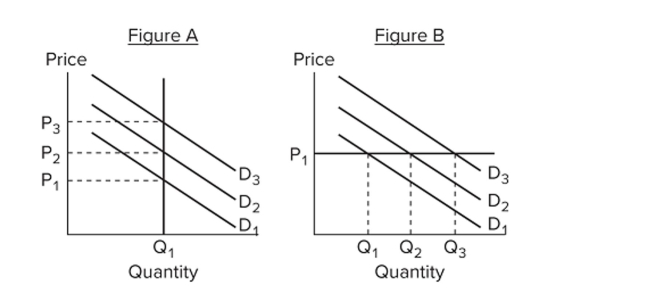 Refer to the figures. Which figure(s) represent(s) a situation where prices are flexible?
Refer to the figures. Which figure(s) represent(s) a situation where prices are flexible?A) A only
B) B only
C) both A and B
D) neither A nor B

Unlock Deck
Unlock for access to all 243 flashcards in this deck.
Unlock Deck
k this deck
52
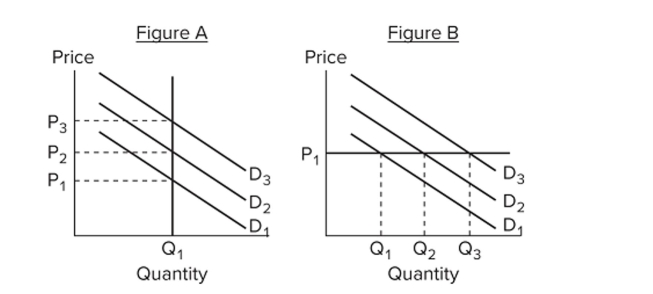 Refer to the figures. Which of the following events would most likely result in higher unemployment?
Refer to the figures. Which of the following events would most likely result in higher unemployment?A) a shift from D2 to D1 in Figure A
B) a shift from D2 to D3 in Figure A
C) a shift from D2 to D1 in Figure B
D) a shift from D2 to D3 in Figure B

Unlock Deck
Unlock for access to all 243 flashcards in this deck.
Unlock Deck
k this deck
53
Prices tend to be sticky because
A) firms are worried that frequent price changes would annoy consumers.
B) most firms have agreements with each other to fix prices at profit-maximizing levels.
C) government controls most prices.
D) foreign competition discourages domestic firms from price changes.
A) firms are worried that frequent price changes would annoy consumers.
B) most firms have agreements with each other to fix prices at profit-maximizing levels.
C) government controls most prices.
D) foreign competition discourages domestic firms from price changes.

Unlock Deck
Unlock for access to all 243 flashcards in this deck.
Unlock Deck
k this deck
54
Kara's Kittens typically produces and sells at its optimal (lowest per-unit cost) level of 30 scratching posts per week. Kara's also maintains an inventory of 20 scratching posts. If prices are sticky and
There is a positive demand shock this week resulting in demand for 40 scratching posts, we would
Expect Kara's to
A) sell the additional scratching posts out of its inventory and rebuild the inventory later when a negative demand shock occurs.
B) permanently expand production to 40 scratching posts per week.
C) raise prices on scratching posts.
D) introduce a new line of scratching posts.
There is a positive demand shock this week resulting in demand for 40 scratching posts, we would
Expect Kara's to
A) sell the additional scratching posts out of its inventory and rebuild the inventory later when a negative demand shock occurs.
B) permanently expand production to 40 scratching posts per week.
C) raise prices on scratching posts.
D) introduce a new line of scratching posts.

Unlock Deck
Unlock for access to all 243 flashcards in this deck.
Unlock Deck
k this deck
55
The average amount of time between price changes for gasoline is
A) two to three days.
B) two to three weeks.
C) two to three months.
D) two to three years.
A) two to three days.
B) two to three weeks.
C) two to three months.
D) two to three years.

Unlock Deck
Unlock for access to all 243 flashcards in this deck.
Unlock Deck
k this deck
56
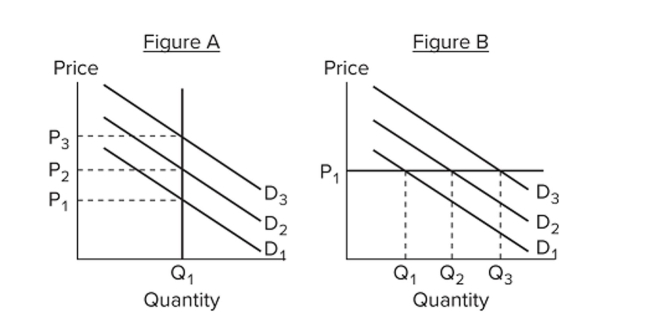 Refer to the figures. Which of the following events would most likely result in inflation?
Refer to the figures. Which of the following events would most likely result in inflation?A) a shift from D2 to D1 in Figure A
B) a shift from D2 to D3 in Figure A
C) a shift from D2 to D1 in Figure B
D) a shift from D2 to D3 in Figure B

Unlock Deck
Unlock for access to all 243 flashcards in this deck.
Unlock Deck
k this deck
57
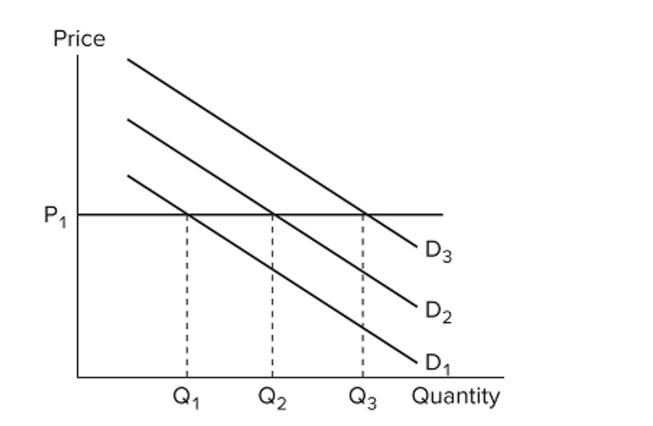 Refer to the figure. Assuming this market is representative of the economy as a whole, a negative demand shock will most likely
Refer to the figure. Assuming this market is representative of the economy as a whole, a negative demand shock will most likelyA) cause inflation.
B) increase unemployment.
C) lower prices but leave output unaffected.
D) reduce both prices and output.

Unlock Deck
Unlock for access to all 243 flashcards in this deck.
Unlock Deck
k this deck
58
Which of the following results from firms holding inventories?
A) The economy is much more susceptible to business cycle fluctuations.
B) Demand shocks occur with greater frequency.
C) Demand shocks occur less frequently.
D) Firms can maintain production levels and adjust inventories in response to demand shocks.
A) The economy is much more susceptible to business cycle fluctuations.
B) Demand shocks occur with greater frequency.
C) Demand shocks occur less frequently.
D) Firms can maintain production levels and adjust inventories in response to demand shocks.

Unlock Deck
Unlock for access to all 243 flashcards in this deck.
Unlock Deck
k this deck
59
Which of the following best explains why prices tend to be inflexible even when demand changes?
A) Government regulations limit the number of times a firm can change prices in a year.
B) In most industries the profit-maximizing price does not change even when demand changes.
C) Production costs do not tend to change when a firm varies its level of output.
D) Firms may be reluctant to change prices for fear of setting off a price war or losing customers to rivals.
A) Government regulations limit the number of times a firm can change prices in a year.
B) In most industries the profit-maximizing price does not change even when demand changes.
C) Production costs do not tend to change when a firm varies its level of output.
D) Firms may be reluctant to change prices for fear of setting off a price war or losing customers to rivals.

Unlock Deck
Unlock for access to all 243 flashcards in this deck.
Unlock Deck
k this deck
60
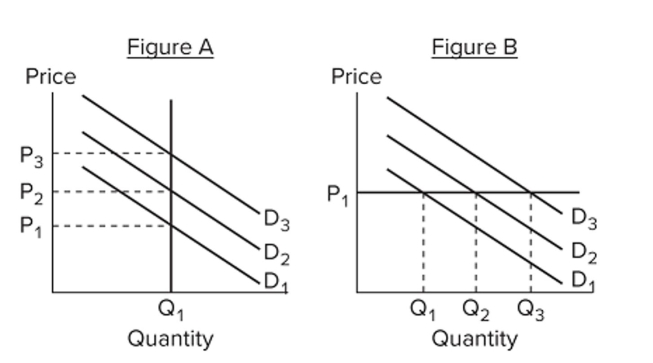 Refer to the figures. Which figure(s) represent(s) a situation where negative demand shocks can result in a recession?
Refer to the figures. Which figure(s) represent(s) a situation where negative demand shocks can result in a recession?A) A only
B) B only
C) both A and B
D) neither A nor B

Unlock Deck
Unlock for access to all 243 flashcards in this deck.
Unlock Deck
k this deck
61
(Consider This) Suppose that Toyota buys a factory previously owned by Chrysler Motors. Economists would
A) consider this to be an economic investment.
B) not consider this to be an economic investment, because Toyota is less efficient than Chrysler.
C) not consider this to be an economic investment, because no new capital is created through the purchase.
D) not consider this to be an economic investment, because there is no way to know how it will affect stock holdings in the two companies.
A) consider this to be an economic investment.
B) not consider this to be an economic investment, because Toyota is less efficient than Chrysler.
C) not consider this to be an economic investment, because no new capital is created through the purchase.
D) not consider this to be an economic investment, because there is no way to know how it will affect stock holdings in the two companies.

Unlock Deck
Unlock for access to all 243 flashcards in this deck.
Unlock Deck
k this deck
62
Any person without a job is considered to be unemployed.

Unlock Deck
Unlock for access to all 243 flashcards in this deck.
Unlock Deck
k this deck
63
Real GDP measures the change in the price level over time.

Unlock Deck
Unlock for access to all 243 flashcards in this deck.
Unlock Deck
k this deck
64
A nation that realizes a 3 percent increase in its output per person is experiencing modern
economic growth.
economic growth.

Unlock Deck
Unlock for access to all 243 flashcards in this deck.
Unlock Deck
k this deck
65
Output per person has grown steadily since the beginning of the Roman Empire.

Unlock Deck
Unlock for access to all 243 flashcards in this deck.
Unlock Deck
k this deck
66
Higher unemployment rates are linked with higher crime rates and higher rates of physical and
mental illness.
mental illness.

Unlock Deck
Unlock for access to all 243 flashcards in this deck.
Unlock Deck
k this deck
67
The business cycle reflects both short-run fluctuations in output and long-run economic growth.

Unlock Deck
Unlock for access to all 243 flashcards in this deck.
Unlock Deck
k this deck
68
The overall behavior of the economy
A) is remarkably stable over time.
B) differs over time as prices become increasingly flexible in the months and years following a shock.
C) differs over time as prices become increasingly sticky in the months and years following a shock.
D) is easily controlled and stabilized by government policy.
A) is remarkably stable over time.
B) differs over time as prices become increasingly flexible in the months and years following a shock.
C) differs over time as prices become increasingly sticky in the months and years following a shock.
D) is easily controlled and stabilized by government policy.

Unlock Deck
Unlock for access to all 243 flashcards in this deck.
Unlock Deck
k this deck
69
A period of declining output and living standards is referred to as a recession.

Unlock Deck
Unlock for access to all 243 flashcards in this deck.
Unlock Deck
k this deck
70
Inflation reduces the purchasing power of a person's income and savings.

Unlock Deck
Unlock for access to all 243 flashcards in this deck.
Unlock Deck
k this deck
71
In 2008-2009, the U.S. economy lost 8 million jobs and saw the economic growth rate fall to
negative 2.4 percent.
negative 2.4 percent.

Unlock Deck
Unlock for access to all 243 flashcards in this deck.
Unlock Deck
k this deck
72
(Consider This) Which of the following is an example of economic investment?
A) Volvo buys an old factory building from General Motors.
B) Nike buys a new machine that increases shoe production.
C) Bill Gates buys shares of stock in IBM.
D) Warren Buffet buys U.S. savings bonds.
A) Volvo buys an old factory building from General Motors.
B) Nike buys a new machine that increases shoe production.
C) Bill Gates buys shares of stock in IBM.
D) Warren Buffet buys U.S. savings bonds.

Unlock Deck
Unlock for access to all 243 flashcards in this deck.
Unlock Deck
k this deck
73
(Consider This) In 2008 and 2009, the United States experienced what has come to be known as the
A) Great Depression.
B) Great Recession.
C) Great Expansion.
D) Great Stagnation.
A) Great Depression.
B) Great Recession.
C) Great Expansion.
D) Great Stagnation.

Unlock Deck
Unlock for access to all 243 flashcards in this deck.
Unlock Deck
k this deck
74
In order to achieve modern economic growth, a nation's output must grow faster than its population.

Unlock Deck
Unlock for access to all 243 flashcards in this deck.
Unlock Deck
k this deck
75
(Consider This) The U.S. recession that occurred in 2008 and 2009 represented a case where
A) government policy intervention effectively offset the negative demand shock and minimized the effects on output and employment.
B) prices were somewhat flexible, so the impact of the demand shock was felt about the same in terms of price and output changes.
C) prices were relatively flexible, minimizing the impact on total output and employment.
D) prices were relatively sticky and most of the impact was on total output.
A) government policy intervention effectively offset the negative demand shock and minimized the effects on output and employment.
B) prices were somewhat flexible, so the impact of the demand shock was felt about the same in terms of price and output changes.
C) prices were relatively flexible, minimizing the impact on total output and employment.
D) prices were relatively sticky and most of the impact was on total output.

Unlock Deck
Unlock for access to all 243 flashcards in this deck.
Unlock Deck
k this deck
76
(Consider This) What is the difference between financial investment and economic investment?
A) There is no difference between the two.
B) Financial investment refers to the purchase of financial assets only; economic investment refers to the purchase of any new or used capital goods.
C) Economic investment is adjusted for inflation; financial investment is not.
D) Financial investment refers to the purchase of assets for financial gain; economic investment refers to the purchase of newly created capital goods.
A) There is no difference between the two.
B) Financial investment refers to the purchase of financial assets only; economic investment refers to the purchase of any new or used capital goods.
C) Economic investment is adjusted for inflation; financial investment is not.
D) Financial investment refers to the purchase of assets for financial gain; economic investment refers to the purchase of newly created capital goods.

Unlock Deck
Unlock for access to all 243 flashcards in this deck.
Unlock Deck
k this deck
77
Nominal GDP measures a nation's output in current year prices.

Unlock Deck
Unlock for access to all 243 flashcards in this deck.
Unlock Deck
k this deck
78
Economists and policymakers are generally more concerned about nominal GDP than real GDP.

Unlock Deck
Unlock for access to all 243 flashcards in this deck.
Unlock Deck
k this deck
79
Modern economic growth refers to any situation where a nation's output increases.

Unlock Deck
Unlock for access to all 243 flashcards in this deck.
Unlock Deck
k this deck
80
The business cycle is primarily concerned with changes in the level of overall prices over time.

Unlock Deck
Unlock for access to all 243 flashcards in this deck.
Unlock Deck
k this deck



